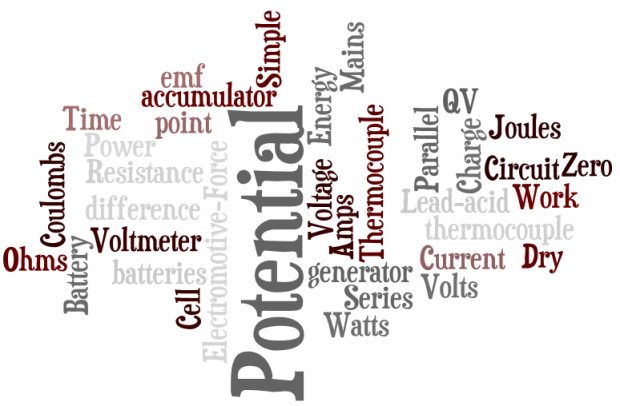 Image created with wordle.net
Image created with wordle.net
Potential difference (commonly known as ‘voltage’) is probably one of the least well understood concepts in Leaving Cert Physics.
Not only is it difficult to understand such an abstract concept (it’s not like you can hold a bunch of voltage in your hand), but the meaning of the term ‘voltage’ has itself changed over the years, and you’re left to make sense of the remaining muddle.
If you think I’m just saying this to make you feel better, read on.
The following extract has been taken from the minutes of a History of Science meeting in 2002.
John Roche, of Linacre College, Oxford, opened the session after tea, speaking on the concept of voltage. He began by claiming that almost every concept in electricity and electromagnetism is ambiguous, and the concept of voltage is one of the most incoherent. Its evolution in difficult to follow.
Abbé Nollet, in the 18th century, distinguished quantity and degree of electrification. Others made similar distinctions between quantity and intensity or tension or pressure – what we would call voltage.
Roche showed how the term “voltage” had come to be used nowadays in three different ways; for electromotive force, potential difference and (absolute) potential.
Volta defined electrical tension as the endeavour of the electrical fluid to escape from a body. Volta’s tension was more akin to a force, unlike the modern definition of electromotive force, which is a misnomer, being defined in terms of energy.
Ohm carried Volta’s concept to closed circuits with the idea that voltage was proportional to the difference in tension between the ends of a conductor. For Ohm, it was the gradient of electrical tension that drove the current.
Poisson introduced an entirely different concept, of charge divided by distance to a point, which Green called the potential. This was an analytical device only, arising from an analogy with Laplace’s gravitational potential function.
Kirchhoff reconciled Volta’s tension with Poisson’s potential function through the concept of energy or vis viva introduced by Helmholtz. From Kirchhoff, current is driven by the electric field in a conductor and voltage is related to the energy supplied, but physicists and electrical engineers do not usually think of them in this way.
All the earlier interpretations remain current, but with different weights, and most of the time voltage is seen as a driving energy.
IOP History of Physics Group Newsletter, Spring 2000, page 65
With thanks to @draziraphale for prompting this post